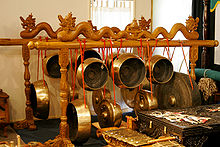Gamelan Gong Kebyar
| Music of Indonesia | |
|---|---|

Kempul gongs from Java
|
|
| Genres | |
| Specific forms | |
| Regional music | |
Gamelan gong kebyar is a style or genre of Balinese gamelan music. Kebyar means "the process of flowering", and refers to the explosive changes in tempo and dynamics characteristic of the style. It is the most popular form of gamelan in Bali, and its best known musical export.
Gong kebyar music is based on a five-tone scale called pelog selisir (tones 1, 2, 3, 5, and 6 of the 7-tone pelog scale), and is characterized by brilliant sounds, syncopations, sudden and gradual changes in sound colour, dynamics, tempo and articulation, and complex, complementary interlocking melodic and rhythmic patterns called kotekan.
Gamelan gong kebyar was first documented to exist in North Bali in the early 1900s. The first public performance was in December 1915 at a gamelan gong competition in Jagaraga, North Bali. Ten years later, I Mario of Tabanan is said to have created kebyar dance to accompany the music.
Following their violent invasion of the island, Dutch occupiers responded to international criticism by building cultural institutions. They sponsored these competitions until Japanese forces ended their rule in World War II.
In addition to island-wide arts competitions, gamelan gong kebyar has become an essential part of modern Bali Hindu ceremonies. They are required for annual birthday ceremonies for temples, odalan, as well as major holidays as accompaniment for sacred dances. They are also appropriate for the class of rituals centered around human life, Putra Manusia, such as weddings.
Instruments in gamelan gong kebyar offer a wide range of pitches and timbres, ranging five octaves from the deepest gongs to the highest key on a gangsa. The high end can be described as "piercing", the low end "booming and sustained," while the drums as "crisp". Kebyar instruments are most often grouped in pairs, or "gendered." Each pair consists of a male and female instrument, the female being slightly larger and slightly lower in pitch. See tuning in this article to learn why this is.
...
Wikipedia
